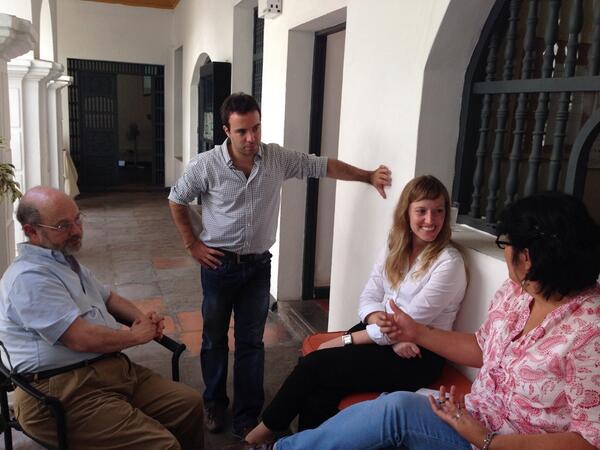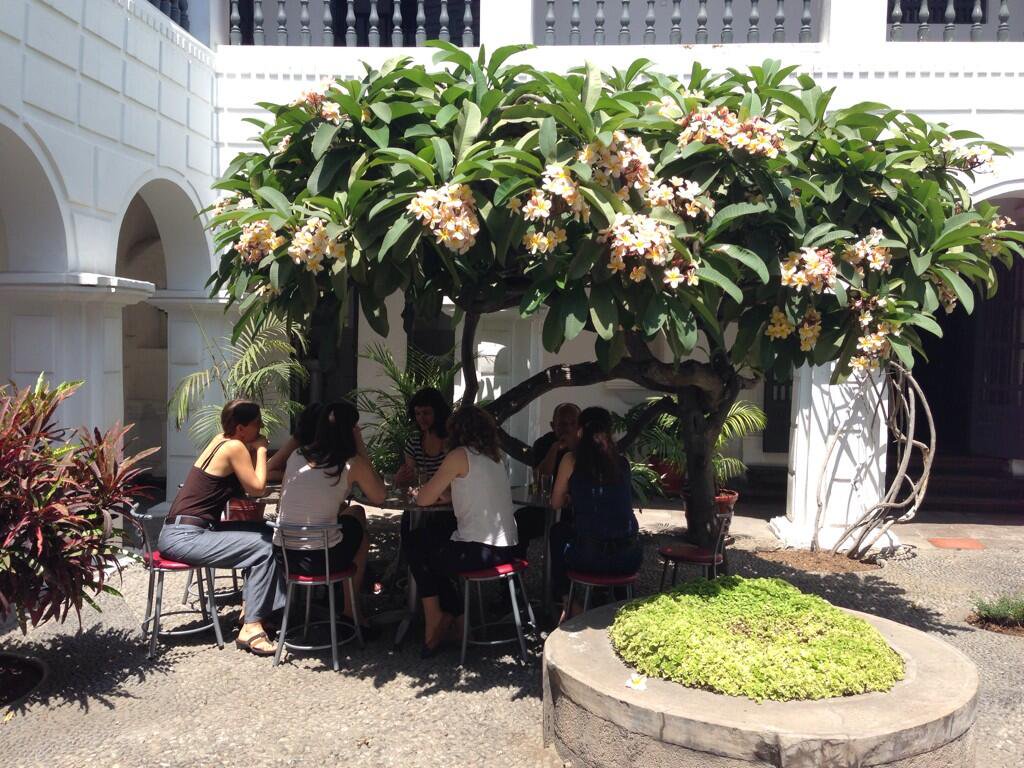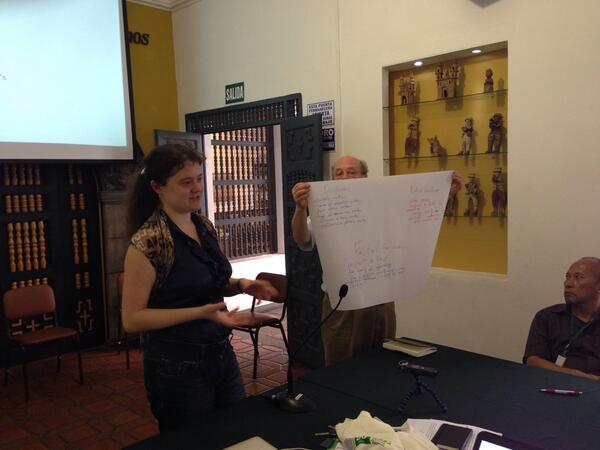Researchers from 10 countries met in Lima for the first day of a 4 day workshop to launch The Exchange. Follow them via: #TheExchangeLima.
The new agenda provides opportunities for the participants to get to know each other, reflect on their own past collaboration experiences, learn about key organisational development and policy issues, and plan the next steps of the programme.
The morning sessions were dominated by introductions and an open discussion about the history of The Exchange. Goran Buldioski, representing The Exchange’s main funders explained how the original idea came about.

Stephen, Leandro, Renata and Rosa
He emphasised that it had been driven by a long term effort to support collaborations in Think Tank Fund (TTF) countries and as well as between think tanks there and in other regions.
An important lesson they had learned, he said, is that collaborations cannot be dictated. Successful collaborations need to grow organically and donors are not always the best placed actors to promote them.
To test their ideas they, and the Think Tank Initiative (TTI), launched a call for proposals for an exchange programme. This exchange programme would, as originally designed, support research collaborations among a number of think tanks from all the regions of the combined TTI and TTF area of work over a year.
In response, Stephen Yeo and Enrique Mendizabal developed an alternative. This is explained in the Theory of Change for The Exchange.
This alternative is characterised by four components:
- A barrier to collaborations action research project;
- Policy and Organisational Development knowledge sharing and training;
- Collaborative research projects based on these policy and organisational development issues; and
- Collaborative learning (ongoing and public)
Central to the delivery of these are two important mechanisms:
- Events (both meetings and webinars or online discussions) to:
- Enable the interaction between the participants to foster new relationships and collaboration;
- Learning about, developing a plan, and implementing a collaborative research project on either a Policy issue or an Organizational Development issue (in teams of two or more); and
- Contribute to the action learning aspects of the project.
- A digital communication strategy aimed at developing and sustaining spaces of engagement including:
- A blog to share resources, presentations, reflection and feedback;
- On going tweeting and dissemination through social networks;
- Shared spaces such as a common flicker album, a shared #, and more to come;
- A google group for the participants and others directly involved in The Exchange.
The plan is to organise at least 4 events throughout the next two years with webinars and online discussions in between. Possible dates include:
- 25th March 2014 –in Lima
- Around June 2014*
- Around October 2014
- Around April 2015
The participants had some questions about the process so far as well, including:
How did we choose the participants?
We sought to find the right mix between the participants. At the same time we ensured that they had submitted the best applications.
After an initial review of the applications, the TTI and the TTF identified their favourites, in some cases using their own knowledge of the regions and the organisations. Stephen Yeo and Enrique Mendizabal put forward a final proposal that was further discussed.
While the plan was to work with only 8 think tanks, 2 more from Indonesia were included when the KSI joined he initiative. These were judged by the same standards as the rest.
Why are there more women than men among the participants?
There were more women applicants than men. We did not take this into account when choosing the final 10. (We asked, at the meeting, if most of the researchers at their organisations were men or women. With the exception of one Indonesian research centre all said that there were more women than men in their organisations. This is an interesting research question.0
Are there any think tanks that we wished had made it?
We were surprised that not more think tanks from Africa applied. Even more surprised that none from South Asia applied. But rather that fudge the process to include them we all felt it appropriate to respect the application process. This, too, is part of the pilot and therefore a source of lessons.
What is the role of the steering committee (and of the think tanks’ directors)?
The proposal considers using the directors to support the organisation of and learning after each meeting. This may be too big an ask from them. We are still considering, with the participants, what may be more appropriate.
There was some consensus on their motivations to apply:
- They felt that the approach proposed was surprisingly flexible and open;
- The focus on the participants’ interests rather than specific research or policy projects was appealing; and
- They were interested in an approach that suggested that they would not be passive recipients of information but that they would be active ‘learners’;
These constitute important standards to keep an eye on and maintain throughout The Exchange.
—-

Francesca, Radka, Petra, Irina, Bambang and Nadia
During the afternoon session the participants had time to reflect on a series of papers that they prepared before the meeting. In them they had written about their own and their organisation’s collaboration experiences.
We will publish versions of these papers as soon as they are edited by the authors. A number of key lessons and ideas can be identified at this stage (among others):
- The papers agree in identifying a difference between domestic and international collaborations. The latter pose greater challenges for the think tanks, particularly when they involve organisations that act as funders or intermediaries of international donors. In general they feel they are ‘used’ rather than treated as equals.
- There were also a number of internal and external factors affecting the success of collaborations. Some organisations are not suited for collaboration. Their size, organisational culture, business models, funding models, etc. can affect how their researchers and managers engage with peers in their own countries or abroad.
- Collaboration has different objectives. These include undertaking research, influencing policy, learning from each other or together, and, even, accessing funds. Each can be judged in different ways.
- Collaborations can fail to deliver their intended objectives but can still be valuable. They can provide think tanks with new contacts, new ideas, access to new spaces, lessons for future collaboration, etc.

Nadia, Stephen and Bambang
In the end, the participants identified a number of criteria to study the drivers, barriers, opportunities, and threats to collaboration. These will serve as a guide to develop more detailed case studies to be published as blogs on this website int he coming months.


 Previous
Previous
